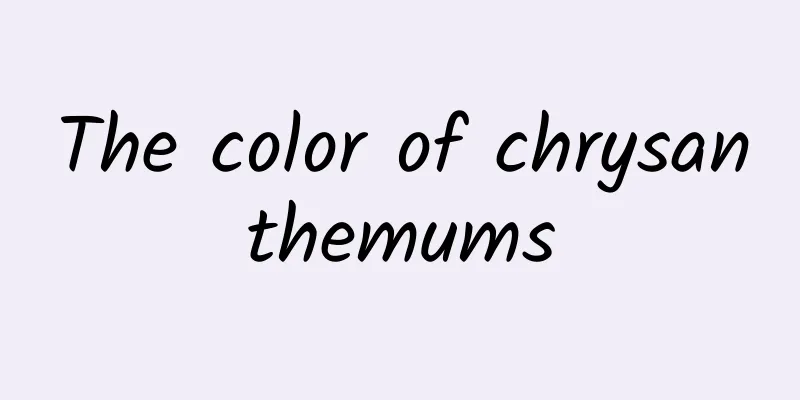The color of chrysanthemums

|
As we all know, chrysanthemum is one of the top ten famous flowers in China. Chrysanthemum blooms in autumn, when all flowers are withering, and when the autumn wind sweeps the fallen leaves. In the eyes of ancient poets, chrysanthemum is a symbol of elegance and noble character. However, in recent years, after artificial selection and cultivation, the number of chrysanthemum varieties has gradually reached more than a thousand. Chrysanthemum is not only ornamental but also has high medicinal value. Therefore, chrysanthemum has gradually been called "artistic chrysanthemum" and "Bao chrysanthemum". Chrysanthemum is a perennial herbaceous plant of the Asteraceae family. In China, poets and painters of all generations have liked to use chrysanthemum as a subject for inscriptions, poems and paintings, because chrysanthemum is endowed with a special personality symbol and special personality implication. However, with the development of artificial cultivation technology, the types and colors of chrysanthemums are also increasing. Let’s share the colors of chrysanthemums below. Chrysanthemum (Dendranthemamorifolium) is a cultivated species of the genus Chrysanthemum in the Asteraceae family. It is a precious ornamental flower bred through long-term artificial selection. It is also called artistic chrysanthemum and abalone chrysanthemum. There are more than a thousand varieties. Perennial herb. Plant height is 20-200cm, usually 30-90cm. The stems are light green or brown in color, and except for the cliff chrysanthemum, most of them have upright branches and are semi-lignified at the base. The leaves are single and alternate, ovate to oblong, with notched and serrated edges. The inflorescence is terminal or axillary, one or several flowers in clusters. The ligulate flowers are female flowers, and the tubular flowers are bisexual flowers. The ligulate flowers are divided into four categories: flat, spoon-shaped, tubular, and deformed. They are rich in colors, including red, yellow, white, black, purple, green, orange, pink, brown, snow-blue, and light green. The tubular flowers develop into "petals" of various colors, including red, yellow, white, purple, green, pink, complex colors, and intermediate colors. The inflorescences vary in size and shape, some are single-petaled, some are double-petaled; some are flat, some are spherical; some have long fluff, some have short fluff, some have flat fluff, and some have curly fluff; some are hollow, some are solid; some are upright, and some are drooping. There are many styles and complex varieties. Depending on the flowering period, there are early chrysanthemums (blooming in September), autumn chrysanthemums (October to November), late chrysanthemums (December to January), August chrysanthemums, July chrysanthemums, May chrysanthemums, etc. According to the size of the flower diameter, the flower diameter above 10 cm is called large chrysanthemum, the flower diameter between 10-6 cm is called medium chrysanthemum, and the flower diameter below 6 cm is called small chrysanthemum. According to the petal shape, it can be divided into three categories, namely flat petals, tubular petals and spoon petals, and more than ten types. Chrysanthemum has the effects of clearing away heat, detoxifying and reducing swelling. It has inhibitory effects on Staphylococcus aureus, Corynebacterium diphtheriae, Streptococcus, Pseudomonas aeruginosa, Trichoderma, and influenza virus. Clinical use: 1. For upper respiratory tract infection and influenza: 9g each of chrysanthemum, honeysuckle, forsythia, and burdock, 6g each of mint and licorice, decocted in water and taken orally. 2. Acute suppurative inflammation: 30-60g of fresh wild chrysanthemum and leaves, decocted in water and taken frequently. Also use 30-60g of its flowers and leaves, decocted in water, and used for external washing or mashing and applying to the affected area. 3. Hypertension: 15g each of wild chrysanthemum and cassia seed, soak in water and drink as tea (especially suitable for liver heat type hypertension). 4. Sore throat, scrofula, red and swollen eyes, etc.: Can be used in combination with other medicines. The above is a brief introduction to the color of chrysanthemum. In addition to its great ornamental value, chrysanthemum also has great medicinal value. Chrysanthemum can be used as tea, which has the effects of reducing internal heat, nourishing the liver, improving eyesight, and beautifying. It can also be used as a drug formula, which has good effects of dispersing wind-heat, clearing away heat and detoxifying, anti-bacterial, anti-inflammatory, lowering blood pressure, and preventing coronary heart disease. |
Recommend
The efficacy and function of carp gall
Many people know that carp bile has unique therap...
The efficacy and function of toad liver
Speaking of toad liver, I believe many friends kn...
Plants vs. Zombies: The Brain, the Most Thoughtful Virus →
1. Prophecy Xiaobai: Oh, genuine software is so e...
What are the effects of Astragalus tablets?
Many people see a lot of medicines in life. Astra...
The efficacy and function of Acorus calamus
Diseases are very harmful to human health. Theref...
Important release! A chart to understand the white paper "China's Space in 2021"
Source: Science and Technology Daily Editor: Zhan...
What are the traditional Chinese medicine formulas for tonifying the kidney and strengthening yang?
Many men may be particularly concerned about thei...
The stronger the immune system, the better? Not necessarily! Be careful of this "immortal cancer"!
Not long ago, #13-year-old girl suffers from lupu...
Your depression can be improved through food
French fries, cola, fried chicken... When I feel ...
Does drinking before bed really help you sleep? Stop doing this! The harm is worse than insomnia!
"Drinking before bed can help you sleep.&quo...
Beijing Winter Olympics: How does China produce the world's "fastest" ice?
Mixed Knowledge Specially designed to cure confus...
What are the benefits of eating goji berries?
Lycium barbarum is a traditional Chinese medicine...
A forest elf, a trio of high-pitched songs, what kind of mysterious bird is this?
A bird's eye view of science Quanzhou Associa...
Is the ability to withstand stress inherited from the “mother” considered a cheat?
Produced by: Science Popularization China Produce...
The efficacy and function of goat meat
Only when we understand the main ingredients of a...



![[Creative Cultivation Program] "From fish to humans" has more evidence, is the human middle ear transformed from fish gills?](/upload/images/67f0e4e6207b1.webp)





